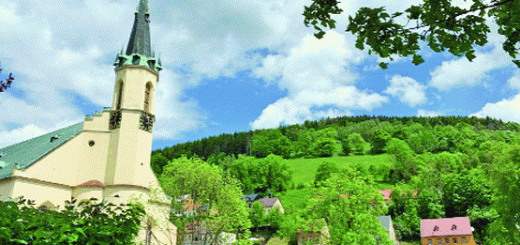The Town Where The Lighting Is Alive
In a tranquil side room of the Covid-19 vaccination centre in Rambouillet, a small French town around 30 miles (50km) south-west of Paris, a soft blue light emanated from a row of cylindrical tubes. Members of the public who received a vaccine last year were invited to bathe in the glow for a few minutes while they waited in the recovery area.
Soon, the same azure glow will illuminate the nearby, tree-lined Place André Thomé et Jacqueline Thomé-Patenôtre, located just across from the aptly named La Lanterne performance hall, at night. These ethereal experiments are also underway across France, including at the capital’s Roissy-Charles-de-Gaulle airport.
But unlike standard streetlamps, which often emit a harsh glare and need to be hooked up to the electricity grid, these otherworldly lights are powered by living organisms through a process known as bioluminescence.
This phenomenon – where chemical reactions inside an organism’s body produce light – can be observed in many places in nature. Organisms as diverse as fireflies, fungi and fish have the ability to glow through bioluminescence. It is present in 76% of deep-sea creatures and has independently evolved dozens of times, including at least 27 occasions in marine fish alone.
The uses of bioluminescence in the natural world are just as wide-ranging. Fireflies light up to attract mates while some species of algae glow when the surrounding water is disturbed. Deepsea anglerfish allow bioluminescent bacteria to take up residence on a lobe above their head as a tantalising lure for prey.
Most bioluminescent ocean species emit a blue-green light, which, due to the shorter wavelengths of the colours, can travel further in the ocean. Some fireflies and certain snails glow yellow, and the so-called “railroad worm”, a beetle larvae native to the Americas, is known to turn both red and greenish-yellow in a dotted pattern that resembles a train at night. Springhares – nocturnal rodents found in southern Africa – have even been found to have hair that produces a vivid pink biofluorescent glow.
The turquoise blue glow bathing the waiting room in Rambouillet, meanwhile, comes from a marine bacterium gathered off the coast of France called Aliivibrio fischeri. The bacteria are stored inside saltwater-filled tubes, allowing them to circulate in a kind of luminous aquarium. Since the light is generated through internal biochemical processes that are part of the organism’s normal metabolism, running it requires almost no energy other than that needed to produce the food the bacteria consume. A mix of basic nutrients is added and air is pumped through the water to provide oxygen. To “turn off the lights”, the air is simply cut off, halting the process by sending the bacteria into an anaerobic state where it does not produce bioluminescence.
“Our goal is to change the way in which cities use light,” says Sandra Rey, founder of the French start-up Glowee, which is behind the project in Rambouillet. “We want to create an ambiance that better respects citizens, the environment and biodiversity – and to impose this new philosophy of light as a real alternative.”
Proponents like Rey argue bioluminescence produced by bacteria could be an energy-efficient, sustainable way to light up our lives. The way we currently produce light, she argues, has changed little since the first light bulb was developed in 1879. While the LED-bulb, which emerged in the 1960s, has significantly reduced the running costs of lighting, it still depends on electricity, which is largely produced by burning fossil fuels.
Founded in 2014, Glowee is developing a liquid raw material – in theory endlessly renewable – made of bioluminescent microorganisms. It is cultivated in saltwater aquariums before being packaged in the aquarium tubes. The manufacturing process, claims Rey, consumes less water than manufacturing LED lights and releases less CO2, while the liquid is also biodegradable. The lights also use less electricity to run than LEDs, according to the company, although the Glowee bulbs produce fewer lumens of light than most modern LED bulbs.
While Glowee’s lights are currently only available in standard tubes for events, the company is planning to produce several types of street furniture, such as outdoor benches with in-built lighting, soon.
In 2019, Rambouillet city hall signed a partnership with Glowee and invested €100,000 (£83,300/$109,000) to turn the town into “a full-scale bioluminescence laboratory”.
Guillaume Douet, head of Rambouillet’s public spaces, believes if the experiment is a success it could lead to a transformation across the country. “This is about a city of tomorrow,” says Douet. “If the prototype really works, we can bring it to a large-scale deployment and replace current lighting systems.”
But bioluminescent lighting isn’t new. In around 350BC, Greek philosopher Aristotle described bioluminescence in glow worms and fireflies as a type of “cold” light. Coal miners have used fireflies in jars as illumination in mines where any kind of flame – even a candle or lantern – could trigger a deadly explosion. Meanwhile, glowing fungi have for years been used by tribes in India to illuminate dense jungles.
Yet Glowee is the first company in the world to reach this level of experimentation, and the company says it is in negotiations with 40 cities across France, Belgium, Switzerland and Portugal. ERDF, a largely state-run company that manages France’s electricity grid, is among Glowee’s backers, the European Commission has provided €1.7m (£1.4m/$1.9) funding and France’s National Institute of Health and Medical Research (Inserm) has given technical support.
However, Carl Johnson, professor of biological sciences at Vanderbilt University, believes there are serious challenges still ahead before bioluminescence can get the green light for large-scale deployment.
“First, you have to feed the bacteria and dilute them as they grow,” he says. “That’s not so easy. Also, the phenomenon will be very temperature-dependent and I doubt that it will work in the winter. Third, bioluminescence is very dim compared to electrical lighting. But perhaps they have improved the luminescence intensity.”
Glowee’s Rey acknowledges those challenges ahead, but insists the benefits, both ecologically and economically, could see future cities bathed in bacterial blue light.
Currently, the Evry-based team is working to increase the light intensity produced by the bacteria – which for now only lasts days or weeks before requiring further nutrients and is not yet as strong as LED lights – by subjecting it to different temperatures and pressures. So far Glowee says its bacteria can produce an output of brightness of 15 lumens per square metre – short of, but not far off, the minimum 25 per square metre it believes is required for public lighting in parks and gardens. By comparison a 220 lumen household LED spotlight bulb can produce about 111 lumens per square metre of floor.
“We are advancing little by little,” she says. “But we’ve made enormous steps already and our philosophy of light is a response to the crisis humanity is facing.”
Catrin Williams, a lecturer at Cardiff University’s School of Biosciences who has studied bioluminescence in bacteria, agrees it is “difficult” to maintain living bacterial cultures long-term due to the need for the supply of nutrients.
But Williams says this could be overcome by focusing on “chemiluminescence” – a process Glowee is also currently investigating – which removes the need for live bacteria. Instead, the enzyme responsible for bioluminescence, luciferase, can in theory be extracted from bacteria and used to produce light itself. “I think the Glowee approach is extremely novel and innovative and could be fantastic,” she says.
Other initiatives around the world are providing further glimmers of hope. Vancouver-based Nyoka Design Labs is developing a biodegradable alternative to glow sticks using non-living, cell-free enzymes, which the creators say are much easier to maintain than living bacteria. “Instead of using the whole car, we just take out the headlights,” says Paige Whitehead, the founder and chief executive. “Enzymology has advanced to the extent that we no longer have to rely on the cell-supported systems.”
Once used, glow sticks cannot be recycled due to the mixture of chemicals they contain. They are used in a wide range of applications, from law enforcement and military uses to music festival goers. Some researchers have raised concerns about the affect the chemicals they contain have on marine life, as they are also often used as lures in longline fishing.
“So much of this waste is unnecessary,” says Whitehead. “The vision we’re going for is to replace any alternative lighting systems to make them more sustainable.”
In a major breakthrough for that vision, a study published in April 2020 revealed a team of Russian bioengineers working with a Moscow-based biotechnology startup who have created a method to sustain bioluminescence in plants. They claim they were able to make plants glow 10 times brighter and for longer than previous efforts – producing over 10 billion photons per minute – by bioengineering bioluminescent genes from fungi into the plants. The new research built on findings that identified a fungal version of luciferin, one of the unique compounds that is necessary for bioluminescence, alongside either of the enzymes luciferase or photoprotein.
Keith Wood, a scientist who 30 years ago created the first luminescent plant using a gene from fireflies, says the technology could in part replace artificial lighting like LEDs. More recently, he found that by altering the genetic structure of a luciferase found in the deep-sea shrimp Oplophorus gracilirostris, its brightness could be increased by 2.5 million times. The resulting enzyme, which the researchers called NanoLuc, was also 150 times brighter than the luciferases found in fireflies.
“The application of synthetic biology onto bioluminescence is a massive opportunity,” says Wood, who is now developing a bioluminescent plant for the company Light Bio.
But exactly how these transgenic bioluminescent plants might be used in the future is still to be decided. One group of designers in Athens, led by Olympia Ardavani at the Hellenic Open University, laid out a vision of large numbers of bioluminescent plants being used to provide ambient lighting along the side of roads. They estimated that if a plant could be produced that would emit around 57 lumens of light each, they would need 40 plants in every 30m (98ft) on each side of the road in order to meet the lowest class of street lighting required on roads used by pedestrians in Europe.
However, Rey believes harnessing the natural power of bioluminescence for lighting could also make us see the environment and natural world in new ways too. “It can create an ambiance that makes us more respectful citizens, of the environment and of biodiversity,” she says.
Written by Peter Yeung















Recent Comments